Great Western Railway (train operating company)
Great Western Railway (GWR)[1] is a British train operating company owned by FirstGroup that operates the Greater Western railway franchise. It manages 197 stations and its trains call at over 270.[2] GWR operates long-distance inter-city services along the Great Western Main Line to and from the West of England and South Wales, inter-city services from London to the West Country via the Reading–Taunton line and the Night Riviera sleeper service between London and Penzance. It also provides commuter and outer-suburban services from its London terminus at Paddington to West London, the Thames Valley region including parts of Berkshire, parts of Buckinghamshire and Oxfordshire; and regional services throughout the West of England and South Wales to the South coast of England. GWR will also be providing and maintaining the new fleet for Heathrow Express from May 2020.[3]
 | |
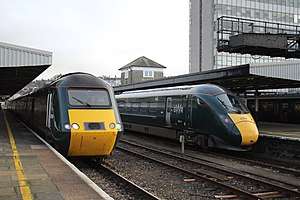 Class 255 Castle and Class 802 IET at Plymouth | |
| Overview | |
|---|---|
| Franchise(s) |
|
| Main region(s) | London, Thames Valley, South West England, South Wales |
| Other region(s) | West Midlands, South East England |
| Fleet size |
|
| Stations called at | over 270 |
| Stations operated | 197 |
| Parent company | FirstGroup |
| Reporting mark | GW |
| Technical | |
| Track gauge | 1,435 mm (4 ft 8 1⁄2 in) standard gauge |
| Electrification | 25 kV 50 Hz AC OHLE |
| Length | 2129.2 |
| Other | |
| Website | gwr |
The company began operating in February 1996 as Great Western Trains, as part of the privatisation of British Rail. In December 1998 it became First Great Western[4] after FirstGroup bought out its partners' shares in Great Western Holdings. In April 2006, First Great Western, First Great Western Link and Wessex Trains were combined into the new Greater Western franchise and brought under the First Great Western brand. The company adopted its current name and a new livery in September 2015 to coincide with the start of an extended franchise that is due to run until 31 March 2023.
History
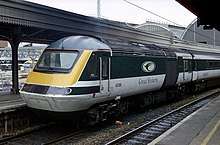
As part of the privatisation of British Rail, the Great Western InterCity franchise was awarded by the Director of Passenger Rail Franchising to Great Western Holdings in December 1995 and began operations on 4 February 1996. Great Western Holdings was owned by some former British Rail managers (51%), FirstBus (24.5%) and 3i (24.5%).[5][6]
In March 1998, FirstGroup bought out its partners' stakes to give it 100% ownership.[7][8][9] In December 1998, the franchise was rebranded as First Great Western.[10]
On 1 April 2004, First Great Western Link began operating the Thames Trains franchise. It operated local train services from Paddington to Slough, Henley-on-Thames, Reading, Didcot, Oxford, Newbury, Bedwyn, Worcester, Hereford, Banbury and Stratford upon Avon. It also operated services from Reading to Gatwick Airport (via Guildford and Dorking), and from Reading to Basingstoke.[11]
On 1 April 2006, the Great Western, Great Western Link and Wessex Trains franchises were combined into a new Greater Western franchise. FirstGroup, National Express and Stagecoach were shortlisted to bid for it. On 13 December 2005, it was announced that FirstGroup had won the franchise.[12] Originally, First planned to subdivide its services into three categories based on routes.[13] Following feedback from staff and stakeholders, the decision was taken to re-brand and re-livery all services as 'First Great Western'.[14]
In May 2011, FirstGroup announced that it had decided not to take up the option to extend its franchise beyond the end of March 2013. FirstGroup stated that, in the light of the £1bn plan to electrify the Great Western route from London via Bristol to Cardiff, it wanted to try to negotiate a longer-term deal. CEO Tim O'Toole said: "We believe we are best placed to manage these projects and capture the benefits through a longer-term franchise."[15]
By not taking up the option to extend its original franchise contract for a further three years, FirstGroup avoided having to pay £826.6m to the government; it received extra subsidies totalling £133m from the government in 2010.[16]
In March 2012 Arriva, FirstGroup, National Express and Stagecoach were shortlisted to bid for the new franchise. The winner was expected to be announced in December 2012, with the new franchisee taking over in April 2013.[17] But it was announced in July 2012 that the franchise would be extended, due to the late issue of the Invitation to Tender (ITT).[18] The ITT ran from the end of July until October 2012. The winner would have been announced in March 2013, and taken on the franchise from 21 July 2013 until the end of July 2028.[19] The new franchise would include the introduction of new Intercity Express Trains, capacity enhancements and smart ticketing.[20] The award of the franchise was again delayed in October 2012, while the Department for Transport reviewed the way rail franchises were awarded.
In January 2013, the government announced that the current competition for the franchise had been terminated, and that FirstGroup's contract had been extended until October 2013.[21] A two-year franchise extension until September 2015 was agreed in October 2013,[22][23] and subsequently extended until March 2019.[24][25][26] A further extension to April 2019 was granted in March 2015.[27]
The refurbishment of first-class carriages in 2014 included interiors that featured a new GWR logo[28] and no First branding. The whole company was rebranded as Great Western Railway (GWR) on 20 September 2015 and introduced a green livery in recognition of the former Great Western Railway.[29][30] The new livery was introduced when HST interiors were refurbished, and on sleeper carriages and Class 57/6 locomotives.[31]
In May 2018, TfL Rail took over services from Paddington to Hayes and Harlington and in December 2019, it took over some stopping services to Reading.[32][33] In March 2020, a further extension to 31 March 2023 was awarded by the DfT with an option to extend for a further year.[34][35]
Routes
Great Western Railway is the primary train operator in Devon, Cornwall, Somerset, Bristol, Berkshire, Wiltshire, Gloucestershire and Oxfordshire.
The following is a simplified list of off-peak weekday service from the December 2019 to May 2020 timetables.
Main line services
| London to South Wales | |||
|---|---|---|---|
| Route | tph | Calling at | Stock |
| London Paddington to Cardiff Central | 1 | Reading, Didcot Parkway, Swindon, Bristol Parkway, Newport | 800 |
| London Paddington to Swansea | 1 | Reading, Swindon, Bristol Parkway, Newport, Cardiff Central, Bridgend, Port Talbot Parkway, Neath 1 train per day continues to Carmarthen | |
| London to Bristol and Somerset | |||
| Route | tph | Calling at | Stock |
| London Paddington to Bristol Temple Meads | 2 | Reading, Didcot Parkway (1tph), Swindon, Chippenham, Bath Spa Some services are extended to Weston-super-Mare and Taunton during peak periods, limited services are extended to Exeter St Davids, Paignton, Plymouth and Penzance. | 800 |
| London to Plymouth and Cornwall | |||
| Route | tph | Calling at | Stock |
| London Paddington to Plymouth | 1tp2h | Reading, Taunton, Tiverton Parkway, Exeter St Davids, Newton Abbot, Totnes | 802 |
| London Paddington to Penzance | 1tp2h | Reading, Taunton, Tiverton Parkway, Exeter St Davids, Newton Abbot, Totnes, Plymouth, Liskeard, Bodmin Parkway, Lostwithiel, Par, St Austell, Truro, Redruth, Camborne, St Erth Services include the Cornish Riviera and Royal Duchy expresses, which run non-stop between Reading and Exeter. | |
| Oxford and The Cotswolds | |||
| Route | tph | Calling at | Stock |
| London Paddington to Oxford | 1 | Slough, Reading | 800 or 802 |
| London Paddington to Great Malvern | 1 | Slough, Reading, Oxford, Charlbury, Finstock (1tpd), Kingham, Moreton-in-Marsh, Honeybourne (1tp2h), Evesham, Pershore, Worcestershire Parkway, Worcester Shrub Hill, Worcester Foregate Street, Malvern Link Some trains continue to Hereford calling at Colwall and Ledbury. Other trains terminate short in Worcester. There is a 1tpd Oxford - Worcester Foregate St. Parliamentary service calling at all stations. | |
| Cheltenham Direct | |||
| Route | tph | Calling at | Stock |
| London Paddington to Cheltenham Spa | 1 | Reading, Didcot Parkway, Swindon, Kemble, Stroud, Stonehouse, Gloucester and Cheltenham Spa trains reverse at Gloucester | 800 |
Commuter and local routes
Great Western Railway operates commuter services between London and destinations such as Slough, Greenford, Reading, Didcot, Oxford, Newbury, Bedwyn, Hereford, Worcester and Banbury. There are also services between Reading and Basingstoke; between Reading and Gatwick Airport via Guildford and Dorking Deepdene on the North Downs Line; and between Bristol and Cardiff via Newport.
Trains also run on various north–south routes from Cardiff, Gloucester and Worcester to Taunton, Weymouth, Salisbury, Southampton, Portsmouth and Brighton. Many of these run via Bristol. The company also runs trains on local routes including branch lines in Devon and Cornwall, such as the Looe, Newquay, Falmouth and St Ives branch lines in Cornwall; the Exmouth, Paignton and Barnstaple branch lines in Devon; and the Gunnislake branch line in Devon and Cornwall.
| Thames Valley Locals | ||||
|---|---|---|---|---|
| Line | Route | tph | Calling at | Stock |
| Great Western Main Line | London Paddington to Didcot Parkway | 2 | Ealing Broadway, Hayes and Harlington, West Drayton, Slough, Maidenhead, Twyford, Reading, Tilehurst, Pangbourne, Goring and Streatley, Cholsey stations between Paddington and Maidenhead are off-peak only | 387 |
| Berks & Hants | London Paddington to Newbury | 1tp2h | Reading train alternates with Exeter semi-fast | |
| Reading to Newbury | 1 | Reading West, Theale, Aldermaston, Midgham, Thatcham, Newbury Racecourse | ||
| London Paddington to Bedwyn | 1 | Reading, Theale, Thatcham, Newbury, Kintbury, Hungerford | 800 | |
| London Paddington to Exeter St Davids | 1tp2h | Reading, Newbury, Pewsey, Westbury, Castle Cary, Taunton, Tiverton Parkway (irregular) Alternates with Newbury express. Some trains continue to Plymouth or Paignton | ||
| Reading–Basingstoke line | Reading to Basingstoke | 2 | Reading West, Mortimer, Bramley | 165 |
| Greenford branch | West Ealing to Greenford | 2 | Drayton Green, Castle Bar Park, South Greenford | |
| Windsor branch | Slough to Windsor & Eton Central | 3 | shuttle | |
| Marlow branch | Maidenhead to Marlow | 1 | Furze Platt, Cookham, Bourne End | |
| Regatta Line | Twyford to Henley-on-Thames | 2 | Wargrave, Shiplake | |
| North Downs Line | Reading to Gatwick Airport | 1 | Wokingham, Blackwater, North Camp, Guildford, Dorking West, Dorking Deepdene, Reigate, Redhill | |
| Reading to Redhill | 1 | Wokingham, Crowthorne, Sandhurst, Blackwater, Farnborough North, North Camp, Ash, Guildford, Shalford, Chilworth (1tp2h), Gomshall (1tp2h), Dorking Deepdene, Betchworth (1tp2h), Reigate trains either serve Chilworth and Gomshall, or Betchworth. | ||
| Oxford Canal Line | Didcot Parkway to Oxford | 1 | non-stop | |
| 1 | Radley doesn't run when Banbury train runs | |||
| Didcot Parkway to Banbury | Appleford, Culham, Radley, Oxford, Heyford, Tackley, Kings Sutton Runs roughly every two hours instead of Didcot-Oxford train. | |||
| Bristol & West Locals | ||||
| Line | Route | tph | Calling at | Stock |
| Severn Beach Line | Bristol Temple Meads to Avonmouth (and Severn Beach) | 3tp2h | Lawrence Hill, Stapleton Road, Montpelier, Redland, Clifton Down, Sea Mills, Shirehampton One train per 2 hours extend to Severn Beach, with some services calling at St Andrews Road Service runs roughly every 40 minutes | 165, 166 |
| Heart of Wessex Line | Great Malvern to Westbury | 1tp2h | Malvern Link, Worcester Foregate Street, Worcester Shrub Hill, Ashchurch for Tewkesbury, Cheltenham Spa, Gloucester, Cam and Dursley, Yate, Bristol Parkway, Filton Abbey Wood, Stapleton Road, Lawrence Hill, Bristol Temple Meads, Keynsham, Oldfield Park, Bath Spa, Freshford, Avoncliff, Bradford-on-Avon, Trowbridge Hourly service exists between Gloucester and Westbury, with Great Malvern and Weymouth extensions approximately every two hours, with some trains doing both and some doing neither. | 158, 165, 166 |
| Gloucester to Weymouth | 1tp2h | Cam and Dursley, Yate, Bristol Parkway, Filton Abbey Wood, Stapleton Road, Lawrence Hill, Bristol Temple Meads, Keynsham, Oldfield Park, Bath Spa, Freshford, Avoncliff, Bradford-on-Avon, Trowbridge, Westbury, Frome, Bruton, Castle Cary, Yeovil Pen Mill, Thornford, Yetminster, Chetnole, Maiden Newton, Dorchester West, Upwey Hourly service exists between Gloucester and Westbury, with Great Malvern and Weymouth extensions approximately every two hours, with some trains doing both and some trains doing neither. | ||
| TransWilts Line | Swindon to Westbury | 1tp2h | Chippenham, Melksham, Trowbridge | |
| South Wales – Somerset | Cardiff Central to Taunton | 1 | Newport, Severn Tunnel Junction, Pilning (Taunton-bound Saturdays only), Patchway, Filton Abbey Wood, Bristol Temple Meads, Nailsea & Backwell, Yatton, Worle, Weston-super-Mare, Highbridge & Burnham, Bridgwater some services extend to Penzance | 158, 255 |
| Bristol Parkway to Weston-super-Mare | 1 | Filton Abbey Wood, Stapleton Road, Lawrence Hill, Bristol Temple Meads, Bedminster, Parson Street, Nailsea & Backwell, Yatton, Worle, Weston Milton Some services run to/from London Paddington and/or Taunton | 165, 166 | |
| Wessex Main Line | Cardiff Central to Portsmouth Harbour | 1 | Newport, Severn Tunnel Junction, Filton Abbey Wood, Bristol Temple Meads, Bath Spa, Bradford-upon-Avon, Trowbridge, Westbury, Warminster, Salisbury, Romsey, Southampton Central, Fareham, Cosham, Fratton, Portsmouth & Southsea | 150, 158, 165, 166 |
| Devon Locals | ||||
| Line | Route | tph | Calling at | Stock |
| Avocet Line | Exmouth to Exeter | 2 | Lympstone Village, Lympstone Commando, Exton, Topsham, Newcourt, Digby and Sowton, Polsloe Bridge, St James Park, Exeter Central, Exeter St Davids, Exeter St Thomas, Starcross, Dawlish Warren, Dawlish, Teignmouth, Newton Abbot, Torre, Torquay trains reverse at Exeter St Davids | 143, 150 |
| Riviera Line | Exeter to Paignton | |||
| Tarka Line | St James Park to Barnstaple | 1 | Exeter Central, Exeter St Davids, Newton St Cyres, Crediton, Yeoford, Copplestone, Morchard Road, Lapford, Eggesford, King's Nympton, Portsmouth Arms, Umberleigh, Chapelton | 150, 158 |
| Cornish Locals | ||||
| Line | Route | tph | Calling at | Stock |
| Atlantic Coast Line | Par to Newquay | 1tp2h | Luxulyan, Bugle, Roche, St Columb Road, Quintrell Downs During summer, local services are cut on certain days which are replaced by expresses to and from London which run non-stop between Par and Newquay. | 150 |
| Looe Valley Line | Liskeard to Looe | 1 | Coombe Junction Halt (2tpd), St Keyne Wishing Well Halt, Causeland, Sandplace Between the peaks, 1tp2h runs non-stop, alternating with stopping service. | |
| Maritime Line | Truro to Falmouth Docks | 2 | Perranwell (1tph), Penryn, Penmere, Falmouth Town | |
| St Ives Bay Line | St Erth to St Ives | 2 | Lelant Saltings (1tpd), Lelant (1tp2h), Carbis Bay | |
| Tamar Valley Line | Plymouth to Gunnislake | 1tp2h | Devonport, Dockyard, Keyham, St Budeaux Victoria Road, Bere Ferrers, Bere Alston, Calstock | |
| Cornish Main Line | Exeter St Davids to Penzance | 1 | Newton Abbot, Totnes, Ivybridge, Plymouth, Devonport, Dockyard, Keyham, St Budeaux Ferry Road, Saltash, St Germans, Menheniot, Liskeard, Bodmin Parkway, Lostwithiel, Par, St Austell, Truro, Redruth, Camborne, Hayle, St Erth some services extend to Cardiff Central. Service is supplemented by London Paddington to Penzance and CrossCountry services. | 158, 255 |
Named trains
Great Western Railway's named passenger trains include:[36]
| Name | Origin | Destination | Other details |
|---|---|---|---|
| The Armada | Plymouth | London Paddington | Penzance on Westbound Friday service |
| The Atlantic Coast Express | London Paddington | Newquay | Summer service |
| The Bristolian | London Paddington | Bristol Temple Meads | Weston-super-Mare Eastbound only |
| The Capitals United | Swansea | London Paddington | Swansea to Paddington early morning service does not call at Reading, Pullman restaurant service available 05.28 ex-Swansea (Mon–Fri only) |
| The Cathedrals Express | Hereford | London Paddington | None |
| The Cheltenham Spa Express | London Paddington | Cheltenham Spa | Eastbound service, Cheltenham Spa to Paddington 12:05 service. |
| The Cornishman | Penzance | London Paddington | Westbound service additionally calls at Pewsey, Westbury & Castle Cary |
| The Cornish Riviera | London Paddington | Penzance | Eastbound service does not call at Newton Abbot |
| The Devon Express | London Paddington | Paignton | 07:30 Westbound only service. No return journey. Weekdays only |
| The Golden Hind | Penzance | London Paddington | Westbound service additionally calls at Newbury and Totnes. Pullman Restaurant available (Mon-Fri) 06:53 Plymouth to Paddington serving breakfast, 18:03 Paddington to Penzance serving dinner. |
| The Mayflower | London Paddington | Plymouth | Non stop Taunton to Reading East & West bound following May 2019 timetable change. |
| The Merchant Venturer | London Paddington | Bristol Temple Meads or Weston-super-Mare | Eastbound only |
| The Night Riviera | London Paddington | Penzance | See Night Riviera |
| The Pembroke Coast Express[37] | London Paddington | Pembroke Dock | Summer Saturday only |
| The Red Dragon[37] | London Paddington | Carmarthen | None |
| The Royal Duchy | London Paddington | Penzance | Eastbound service calls additionally at Tiverton Parkway & Taunton. Pullman Restaurant available on the 12:05 Paddington to Penzance (Mon–Fri only) |
| The Saint David[37] | London Paddington | Swansea | Pullman restaurant service available 10:45 ex-London Paddington (Mon–Fri only) |
| The Torbay Express | London Paddington | Paignton | Westbound service via Bristol TM, Eastbound service via Castle Cary |
| Y Cymro — The Welshman[37] | Swansea | London Paddington | 07:28 Eastbound only |
Onboard services
Pullman Dining
Great Western Railway is the only major UK rail operator with restaurant cars. These operate on certain West Country and Wales trains to or from London Paddington and are available to first class and standard class passengers, though only first class passengers may make advance reservations and have priority over seats in the restaurant.[38] Meals in the restaurant car are not included in the price of rail tickets.
First class

GWR has first class on all its long-distance high-speed services. First class on the IETs includes fabric reclining seating with tables at every seat, as well as an at-seat service provided by a customer host on most journeys.[39] Unlike the previous HSTs, the IETs do not have leather first class seating due to fire regulations.[40] Like the HSTs, there are plug sockets and USB charging points at every seat. There is Wi-Fi throughout the first class carriages, which GWR describes as 'upgraded'.[39]
Standard class
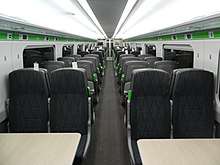
Standard class is provided on all services. Many services on long-distance and regional routes have specific seat reservations.
Trolley service
An at-seat trolley service is scheduled to operate on most IET services, with a trolley in each portion of a 10-coach train. This is different from the previous HSTs, which had buffet counters branded as 'Express Cafes'.
Performance
Punctuality
In 2004–2005, 79.6% of trains arrived on time (defined as within 10 minutes of their scheduled arrival time).[41] On 22 December 2006, the First Great Western InterCity service was declared the worst in Britain for delays, according to figures from the Office of Rail Regulation, with more than one in four trains running late.[42] First was also the only train company to achieve a year-on-year fall in performance results.
First Great Western admitted to misreporting the number of cancellations in the period from August to December 2007, revised figures showing the company to have breached the cancellation threshold in the franchise contract. Specifically the company was alleged to have deliberately cancelled trains on the day prior to service without the prior approval of the Department for Transport, and without recording these cancellations on their performance figures. The company was also accused of falsifying records in order to claim dispensation for large numbers of cancellations.[43] First Great Western was named in a Passenger Focus survey as the worst train operating company for 2007.[44]
On 6 September 2007 FirstGroup announced changes to its management structure, apparently designed to strengthen the First Great Western commuter services. Anthony Smith, head of the rail users council Passenger Focus commented, "A fresh management approach is welcome. Clearly, looking at the passenger satisfaction scores for First Great Western, the train company and Network Rail have a lot to do. However, passengers will believe it when they see improvements."[45]

Some delays are attributable to Network Rail rather than the operator, as the Office of Rail Regulation (ORR) found in September 2007,[46] when it remarked that the First Great Western service continued "to suffer from very high levels of delays attributed to Network Rail" and described Network Rail's performance as "exceptionally disappointing".
By 2009, passenger satisfaction with First Great Western was described by Passenger Focus as having "significantly improved".[47]
The company is no longer the worst-performing UK rail operator, a title which it held for a long period. However, the Which? survey of rail passengers published in February 2013 showed the company scoring lowest of the larger operators with less than 40% satisfaction (Virgin, which topped the poll, managed 67%).[48]
The latest punctuality statistics to be released by Network Rail for period 7 of 2013/2014 were 89.3% PPM (Public Performance Measure) and a MAA (Moving Annual Average) of 88.8% for the 12 months up to 12 October 2013.[49]
Remedial Plan
In February 2008 the Secretary of State for Transport stated that FGW had "fallen persistently short of customers' expectations and been unacceptable to both passengers and government". She issued First Great Western with a Breach Notice for misreporting cancellations and a Remedial Plan Notice as a result of exceptionally high levels of cancellations and low passenger satisfaction. As part of the Remedial Plan Notice, First Great Western was required to achieve improvement milestones, to lease five more Class 150 units to allow three-car trains to be used on Portsmouth-Cardiff services, to undertake a much more extensive refurbishment of the Thames Turbo fleet, to offer 50% higher compensation for the duration of the franchise, to offer 500,000 more cheap tickets on off-peak services, and to improve station customer information systems. Failure to do this would result in FGW losing its franchise. FirstGroup's railway operating profit, meanwhile, was reported to have risen 10% in the six months to September 2007.[50][51]

By June 2009, FGW had transformed its performance to become one of the UK rail network's more punctual operators, recording 94.6% of trains arriving on time.[52] In February 2010 FGW was named Train Operator of the Year at the national Rail Business awards. Presenting the award, judges said, "First Great Western provides an extensive network of commuter, regional, local and intercity trains. The systems they have put into place over the last two years have made a significant improvement to the service they now provide."[53]
However, in February 2015 First Great Western came 17th (out of 21) in Which? magazine's Best and worst UK train companies survey. Customers gave First Great Western a score of 47% (compared to the worst-performing operator, Govia Thameslink Railway, with a score of 43%, and the best-performing operator, Grand Central, with a score of 76%). First Great Western also scored 3 out of 5 stars across five of six specific categories, apart from Value for money in which First Great Western scored 2 out of 5 stars.[54]
Overcrowding
First Great Western has been criticised for overcrowded trains, and in January 2007 commuters on the Bath-Bristol service staged a protest against overcrowding. Participants were issued with imitation tickets printed with "Ticket type: standing only", "Class: cattle truck", "Route: hell and back", "Price: up 12%". The company threatened protestors with criminal prosecution and fines of £5,000, but staff failed to enforce ticket requirements.[56] Alison Forster, First Great Western's Managing Director at that time, apologised to customers.[57]
In January 2008 another fare strike was held as a passenger group said that not enough improvements had been made, despite First Great Western announcing that 2008 season tickets and car-parking charges would be frozen until the end of the year.[58][59]
In August 2010 First Great Western was shown to have operated all the top ten most overcrowded trains in England and Wales, mostly between Reading and London Paddington.[60] By December 2011, this had reduced to two.[61]
In 2011 First Great Western was revealed to be the train company with the highest levels of overcrowding: an average of 16.6% of passengers were shown to be standing during the morning and evening peak times.[62] In 2012 it held the record for the most overcrowded train, carrying nearly twice its capacity, the 07:44 Henley-on-Thames to London Paddington.[61] Paddington, the London terminus for many FGW services, was identified as the most overcrowded station.[60] The company was also listed as the operator with the most passengers in excess of capacity in the south east region in 2012.[63]
Disabled passengers
In July 2018, a disabled woman was threatened by Great Western Railway staff with police action and removal from the train she was travelling in, for using a disabled space for her mobility scooter.[64] Canadian-born comedian Tanyalee Davis, who has a form of dwarfism, said she was humiliated when a Great Western Railway guard made an announcement that she was "causing problems" which had delayed the train. The incident occurred after a woman travelling with a young child demanded that Davis make way for her pram.[65] GWR said the incident should not have happened and "No one travelling with us should be left feeling like this".[66]
Strike action
The pre-imminent arrival of the new Class 800 saw a series of strikes by the RMT union over who has the right to control the doors, First Great Western as it was known at the time, wanted to replace guards with driver-only operation (DOO); however, following several discussions it was agreed to keep guards on all IET services.[67] Another strike took place in early December 2016, amidst a background of ongoing rail strikes on a national level, the RMT ballotted Servest UK workers who were employed on an outsourcing contract to GWR as cleaners; the ballot passed in favour of strike action by 98%. A disruptive transfer period in the outsourcing contract, from Mitie to Servest UK, had resulted in what the RMT referred to as the creation of a "two-tier workforce" amongst cleaners at GWR, with an inequality in pay and working conditions between cleaners employed directly by GWR and those outsourced to Servest UK.[68] Two 24-hour strikes were held between 6 a.m. and 6 a.m. on 16–17 December and 23–24 December,[69] followed by a 48-hour strike between 6 a.m. and 6 a.m. on 19–21 January 2017.[70] Further industrial action was suspended by the RMT following the January strike as a result of an improvement in ongoing negotiations between the RMT, GWR and Servest UK.[71] The dispute was formally resolved in July 2017 as RMT members voted in favour of accepting a new pay deal.[72]
Rolling stock
Great Western Railway inherited a fleet of InterCity 125 sets (Class 43 power cars and Mark 3 Coaches) and Class 57 locomotives and Mark 3 sleeper coaches from BR. In 2006, it inherited a fleet of Class 165 and Class 166 units from First Great Western Link, and a fleet of Class 143, Class 150, Class 153 and Class 158 units from Wessex Trains.
Inter-City services
Class 800 Intercity Express Train
Most Great Western Railway intercity services are operated by a fleet of fifty-seven Class 800 trains from the Hitachi A-train family. GWR operates most of its long-distance services between London and destinations such as Swindon, Chippenham, Bath Spa, Bristol Temple Meads, Cardiff Central, Swansea, Carmarthen, Cheltenham Spa, Oxford, Worcester Shrub Hill and Hereford, using these trains, which gradually replaced the older InterCity 125 sets between Autumn 2017 and Spring 2019. Class 800s may also be used for services to Paignton and Plymouth, although the majority of services to far southwestern destinations are operated using Class 802 trains which have higher engine power to cope with the steeper gradients in the south west of the country.
Class 802 Intercity Express Train
GWR operates most long-distance services between London and destinations in the west of the network (such as Paignton, Newquay, Plymouth and Penzance) using its fleet of thirty-six Class 802 trains, the first of which was introduced on 20 August 2018.[73]
Also in the Hitachi AT300 family, these trains are almost identical to Great Western Railway's fleet of Class 800 trains, the only key difference being that the Class 802 trains have a higher engine operating power—700 kW (940 hp) per engine as opposed to 560 kW (750 hp)—and are fitted with larger fuel tanks to cope with the gradients and extended running in diesel mode on the long unelectrified stretches in Devon and Cornwall.[74]
Sleeper services
Class 57/6 + Mark 3
Four Class 57/6 locomotives haul Night Riviera Sleeper services, and failed HST sets.[75] When these are unavailable, GWR hires Direct Rail Services Class 57/3 locomotives to operate the Night Riviera.[76]
Thames Valley and Bristol services
Class 165/1 Networker Turbo
The Class 165 "Networker Turbo" is a two- or three-coach DMU used on shorter-distance services in the Thames Valley area, with the majority based at Reading Traction Maintenance Depot. They are mainly used on branches such as the Greenford branch line, Slough–Windsor & Eton line, Marlow branch line and Regatta Line. They are also used on services between Reading and Basingstoke, Didcot Parkway and Oxford or Banbury and sometimes services between London and Oxford. Some (eventually all) are based at St Philip's Marsh depot in Bristol, where they work on the most of the lines in the area including the Severn Beach line, Heart of Wessex Line, Golden Valley line and Bristol to Exeter line. From summer 2018, they are due to run on Cardiff Central to Portsmouth Harbour services too. In response to its Remedial Plan Notice, First Great Western undertook a more thorough refurbishment of the Thames Turbo fleet than originally planned:[77] the trains were to be fitted with improved lighting, carpets, toilets, and a revised seating layout.[78] This refurbishment started in September 2016.
Class 166 Networker Turbo Express

The Class 166 "Networker Turbo Express" is a three-coach DMU, similar to the Class 165 units but with an internal layout more suitable for longer-distance services. They are now mostly based at St Philip's Marsh depot in Bristol, where they currently work on the most of the lines in the area including the Wessex Main Line, Severn Beach line, Heart of Wessex Line, Golden Valley line and Bristol to Taunton line.
Class 387/1 Electrostar
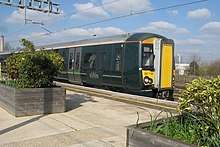
The Class 387 "Electrostar" is a four-coach EMU built by Bombardier, with a 2+2 seating layout, tables, plug-sockets and free Wi-Fi. It can be operated in four, eight- and twelve-coach formations. The class began to enter service in September 2016 on weekday peak services between London Paddington and Hayes & Harlington, using the overhead electrical equipment used by Heathrow Express. Services using the class were extended to Maidenhead in May 2017[79] and later to Didcot Parkway,[80] and from Reading to Newbury.
Bombardier Transportation will modify twelve of these trains by May 2020 at Ilford Depot, providing new first-class seating, Wi-Fi, luggage racks and on-board entertainment to operate Heathrow Express services, replacing the existing Class 332.[81] Several have already been rebranded as "Heathrow Express" and are at GWR's Reading depot; however, they have been stripped to their bare bones inside with GWR moquette taken out of the seats along with the tables.
West of England services
Class 255 Castle (HST Class 43 + Mark 3)
Great Western Railway will be retaining 24 power cars and 48 carriages from its former High Speed Train fleet to form 12 'Castle' 2+4 sets. They are classified as Class 255 sets and will be for use on multiple services between Cardiff, Exeter and Penzance.[82] All power cars being retained will have new nameplates, named after castles from across the area that GWR serve. The sets are progressively being fitted with automatic doors and controlled emission toilets, to allow their operation beyond 2020, at Doncaster Works.[74] Due to a delay in refurbishing the Castle sets, slam door 2+4 sets known as 'Classic' sets were used until the end of 2019. As of January 2020, 8 Castle sets have been converted.
Until 2017, GWR operated the vast majority of its long-distance services with a fleet of 58 InterCity 125 High Speed Train sets,[83] each consisting of eight Mark 3 coaches sandwiched between two Class 43 locomotives. GWR operated the largest InterCity 125 fleet, owning five sets outright; the rest were leased from Angel Trains and Porterbrook. From 2009 to 2012 (when Class 180s were reintroduced on the Cotswold line)[84] all the company's intercity services were worked by HSTs except the Night Riviera sleeper service between London Paddington and Penzance. From late 2017, following the completion of electrification from Hayes & Harlington to the west of England,[85] intercity services gradually became operated by Class 800 IETs, although a few peak services remained operated by HSTs until early 2019. GWR continued to use HSTs on services to Exeter, Plymouth and Penzance until May 2019, when they were all withdrawn in favour of Class 802 units.[86]
The youngest Class 43 locomotive dated from 1982. After a successful trial by Angel Trains and FGW in 2004, two power cars received new MTU engines while two received new Paxman VP185s, fitted by Brush Traction of Loughborough. The MTU engine proved the better option, both for reliability and for emissions, resulting in FGW, Brush and Angel Trains starting the HST Modernisation programme. The last power cars to be re-engineered were released in April 2008, while several other companies' HSTs have now all undergone a similar programme.[87]
GWR's High Speed Train fleet were refurbished by Bombardier in Derby and Ilford between 2006 and 2008,[88] with leather seats introduced in first class, redesigned toilets, a redesigned buffet, and at-seat power points. The company opted for mainly airline seats, giving more seats per train.
Following the Southall and Ladbroke Grove rail crashes, GWR requires its HSTs to have automatic train protection and Automatic Warning System safety systems in operation. If either is faulty, the train is not used.
Class 143 Pacer

First Great Western inherited the small fleet of eight two-coach Class 143 Pacer railbuses from Wessex Trains following the franchise merger in April 2006.[89][90] They are currently used on suburban services in and around Exeter. The Class 143 fleet was fully refurbished during 2008 and 2009, and painted in the same livery as the rest of the West of England fleet.[91] Since they are unable to meet an accessibility requirement, they were due to be withdrawn at the end of 2019, but this was postponed due to a shortfall in replacement stock.[92] Porterbrook, the owners of the stock, have proposed a refurbishment that would make the Class 143 fully accessible.[93] The type is due to be replaced by Class 158 units, cascaded from the Bristol area once the Class 769 units enter service.[94]
All the units are painted in the green GWR livery, 143617, 143618 and 143619 also have a partial interior refurbishment. The first unit repainted was 143603 in July 2017.
Class 150/2 Sprinter
The fleet of 17 two-coach Class 150 Sprinter units was inherited from Wessex Trains as part of the Greater Western franchise shuffle. The fleet had been refurbished by Wessex Trains in 2003, with 2+2 seating arranged in a mixture of 'airline' (face to back) and table seating. The fleet is widespread throughout the former Wessex area, and carried a maroon livery with advertising vinyls for South West Tourism. Each unit was sponsored by a district, town or attraction and carried a unique livery. Most received names of attractions, places and branch lines. Two units were repainted into the new First 'Local' livery, but all units are now due to receive the new green GWR livery. As part of a national fleet shuffle, eight units went to Arriva Trains Wales on 10 December 2006, and were replaced with 8 Class 158 units.
First Great Western received five extra Class 150/2 units in May 2007 as part of its Remedial Plan Notice, to enable three-car Class 158 trains to operate on the Portsmouth-Cardiff services.[77] Five Class 150 sets were hired from Arriva Trains Wales from March 2008 until they were returned in November 2010.
All of Great Western Railway's Class 150/2s are now based at Exeter TMD.
Class 158 Express Sprinter
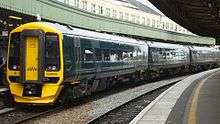
The Class 158 is a two- or three-coach DMU used on regional express services in the former Wessex Trains area. In February 2008, as part of its Remedial Plan Notice, First Great Western announced that it would form some hybrid 3-car Class 158 units in March 2008, made possible by the transfer of five Class 150/2 units from Arriva Trains Wales.[77] There are now ten hybrid units in operation and, combined with the non-hybrid 3-car unit, this provides eleven 3-car units to operate services between Portsmouth and Cardiff, Great Malvern and Brighton, and Great Malvern and Weymouth. After the introduction of Class 150/1 trains from London Overground and London Midland, three of the remaining five 2-coach Class 158s will be reformed to provide two further 3-coach Class 158s.[95]
The fleet was refurbished in a programme begun in 2007,[96] which included fitting of reupholstered seats, new lighting and floor coverings, CCTV within the passenger saloons, and refurbished toilets. At the same time, the exteriors of the vehicles were repainted in the updated FGW livery, including artwork depicting various local places of interest. GWR's Class 158 vehicles were refurbished at Wabtec in Doncaster.[97]
In 2018, the 158s began running alongside the first completed Class 255 Castle set on services between Bristol, Exeter, Plymouth and Penzance. Since then, more of the 158 fleet has gradually started to move more west with more 158 sets working services between Exmouth and Paignton / Barnstaple. The timetable change in December 2019 saw the start of the 158s taking over the 143s on the Tarka Line to Barnstaple primarily, with some of the units also working on the Cardiff / Bristol to Penzance route alongside the Castle sets.[98]
Current fleet
| Trainset | Class | Image | Type | Top speed | Number | Coaches | Routes | |
|---|---|---|---|---|---|---|---|---|
| mph | km/h | |||||||
| Commuter, regional and branch line | ||||||||
| Pacer | Class 143 | DMU | 75 | 120 | 7 | 2 |
| |
| Sprinter | Class 150/2 | DMU | 75 | 120 | 19 | 2 |
| |
| Class 158 Express Sprinter |  |
DMU | 90 | 145 | 11 | 2 |
| |
| 7 | 3 | |||||||
| Networker | Class 165 Network Turbo | 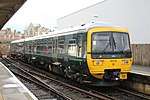 |
DMU | 90 | 145 | 20 | 2 |
|
| 16 | 3 | |||||||
| Networker | Class 166 Networker Turbo Express | DMU | 90 | 145 | 21 | 3 | ||
| Bombardier Electrostar | Class 387 | EMU | 110 | 177 | 33 | 4[102] | London Paddington or Reading – Didcot Parkway or Newbury | |
| InterCity 125 / Class 255 Castle[103] | Class 43 | _at_Saltash.jpg) |
Diesel locomotive | 125 (limited to 100 in service) | 201 (limited to 161 in service) | 28 powercars | 4[104] | Cardiff Central or Bristol Temple Meads – Taunton – Exeter St Davids – Plymouth – Penzance |
| Mark 3 | Passenger coach | 48 coaches | ||||||
| Inter-City | ||||||||
| Hitachi AT300 | Class 800/0 & 800/3 IET | 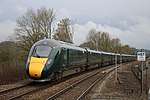 |
BMU | 140 (limited to 125 in service) | 225 (limited to 201 in service) | 36 | 5[105][106] | London Paddington
|
| 21 | 9 | |||||||
| Class 802/0 & 802/1 IET | 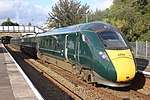 |
BMU | 140 (limited to 125 in service) | 225 (limited to 201 in service) | 22 | 5 | London Paddington
| |
| 14 | 9 | |||||||
| Sleeper | ||||||||
| Night Riviera | Class 57/6 | Diesel locomotive | 95 | 152 | 4 | Varies[lower-alpha 1] |
| |
| Mark 3 | Passenger coach | 110 | 177 | 18 | ||||
| Shunting locomotives | ||||||||
| Class 08 | Shunting locomotive | 15 | 24 | 8 | n/a | Stock movements in depots | ||
- Locomotive-hauled Mark 3 coaches are generally formed of 7–9 coaches for the Night Riviera. They are hauled by a single Class 57.
Future fleet
In April 2018, GWR announced that it was procuring nineteen bi-mode dual-voltage Class 769 units from Spring 2019 for use on Reading to Gatwick, Oxford and mainline suburban services to London Paddington to provide extra capacity and to cover the loss of Class 387 units which will operate the Heathrow Express service.[110]
| Class | Image | Type | Top speed (Diesel) | Top Speed (Electric) | Number | Cars per set | Routes | Built | In service | ||
|---|---|---|---|---|---|---|---|---|---|---|---|
| mph | km/h | mph | km/h | ||||||||
| 769/9 Flex | 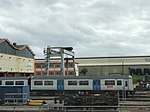 |
BMU | 87 | 140 | 100 | 161 | 19 | 4 |
|
2017–2020 | 2020 |
Past fleet
Former train types operated by Great Western Railway include:
| Trainset | Class | Image | Type | Top speed | Number | Withdrawn | Routes | Notes | ||
|---|---|---|---|---|---|---|---|---|---|---|
| mph | km/h | |||||||||
| Commuter, regional and branch line | ||||||||||
| Pacer | Class 142 |  |
DMU | 75 | 120 | 12 | 2011 |
|
Transferred to Northern Rail | |
| Class 143 | 1 | 2020 | Currently in storage, most likely to be scrapped in the future | |||||||
| Sprinter | Class 150/0 | 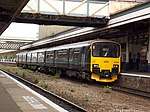 |
2 | Exmouth - Paignton or Barnstaple Cardiff Central or Bristol Temple Meads - Penzance Great Malvern - Brighton Reading - Basingstoke |
Transferred to Northern Trains, meaning that Northern Trains now has both Class 150/0s. | |||||
| Class 150/1 | 17 | 2018 |
|
Transferred to Arriva Rail North, meaning that Arriva Rail North then have all 50 Class 150/1s. | ||||||
| Class 153 Super Sprinter | 14 | 2018–2019 |
|
4 transferred to East Midlands Trains, 5 transferred to Arriva Rail North and then Abellio ScotRail and 5 transferred to Transport for Wales | ||||||
| Inter-City | ||||||||||
| InterCity 125 | Class 43 | Diesel locomotive | 125 | 200 | 95 | 2019 | London Paddington
|
Most transferred to Abellio ScotRail or retained by GWR for use on Castle 2+4 sets. Other sets have been stored too. | ||
| Mark 3 | Passenger coach | 464 | ||||||||
| Alstom Coradia | Class 180 Adelante | DMU | 125 | 200 | 14 | 2017 |
|
Transferred to Grand Central and Hull Trains | ||

Locomotive-hauled trains were in use on services between Cardiff, Bristol, Taunton and Paignton from December 2008 until November 2010 using Virgin Trains Class 57 locomotives with Mark 2 coaching stock. A second set hauled by EWS Class 67s was used between December 2009 and October 2010. These were withdrawn when sufficient DMUs were available following the transfer of six Class 150/1 sets from London Overground.[111] First Great Western issued a tender in May 2013 so that locomotive-hauled trains, or other train formations, could be operated on the Taunton-Cardiff route again, proposed to start in December 2013, to cover for DMUs out of service for refurbishment on Monday-to-Friday diagrams.[112] GWR also runs loco-hauled sets composed of seating coaches and a Class 57 locomotive from the Night Riviera service between Penzance and Exeter St Davids as part of the summer timetable to release a DMU for other services.
Twelve Class 142 Pacer DMUs were received by First Great Western in 2007, starting operations that December. These were loaned from Northern Rail (where they had been stored), in part to cover for refurbishment of FGW's Sprinter fleets but also to allow the Class 158s to be reformed as three coach sets. They were based at Exeter TMD, working alongside the similar Class 143s on services in Devon and Cornwall, including the Avocet Line, Riviera Line and Tarka Line. Five 142s were returned to Northern Rail in late 2008, following the completion of the refresh of Class 150 Sprinter units. The remaining seven units were returned to Northern Rail by November 2011 as they had been replaced by Class 150 units cascaded from London Overground and London Midland following the arrival of new Class 172 Turbostar units.
GWR's Night Riviera service also included the UK's last Motorail service, until that aspect was withdrawn at the end of the 2005 summer season due to low usage.
First Great Western previously leased 14 Class 180 Adelante units, operating on the Great Western Main Line, but following technical issues they were transferred elsewhere.[113][114] In 2012, five units were returned to First Great Western to operate weekday services on the Cotswold Line, allowing class 165 and 166 units to be reallocated to increase capacity on Thames Valley services.[84] The Class 180s left GWR in stages between June and December 2017 to join Grand Central.[115][116]
The 150/1s in the GWR fleet transferred to Arriva Rail North in stages, beginning with the first three in August 2017 when their leases expired,[117] and ending in April 2018.[118] The 153s also transferred elsewhere in stages too, with the first four units going to East Midlands Trains and the next five units going to Arriva Rail North. This left just five 153 units with GWR, which eventually transferred to Transport for Wales in April 2019.[119]
Livery
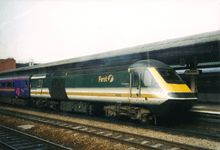

Great Western Trains adopted a livery of dark-green upper body and ivory lower body, with a stylised 'Merlin' bird logo.[120] Following the rebranding as First Great Western, fader vinyls were added to the lower body, with a gold bar containing the stylised FirstGroup F logo and separate Great Western logotype.[121] This livery was sometimes known as the 'fag packet' livery.[122]
When the Class 180 Adelante units were delivered, they were painted in the intercity version of FirstGroup's corporate bus livery. This consisted of a purple-blue base, with pink and gold bars and large pink Fs on the carriage sides and white highlights along the roof and around the driver's cab. The doors were painted white to comply with the Disability Discrimination Act 1995. The HST fleet was repainted to match as they went through overhaul; however, the livery on the power cars was progressively altered to a plain blue base with pink and gold stripes, following problems with dirt build-up on the large white areas.[120]
The rolling stock used on the Night Riviera sleeper service retained the green and gold First Great Western livery until the stock forming these services was refurbished in 2007, when they were painted into 'dynamic lines' livery with vinyls advertising that the coaches operated the 'Night Riviera Sleeper'.
The new Greater Western franchise involved repainting the HST fleet into FirstGroup's 'Dynamic Lines' livery for intercity and commuter services in the former First Great Western and First Great Western Link areas. The livery was initially applied to the HST fleet as they went through refurbishment, although the Class 180 units did not receive the new livery due to the termination of their lease. The commuter units also received the new livery while receiving standard maintenance, as a refurbishment was not originally planned.[123] A second livery known as 'Local Lines' was applied to the DMU fleet, replacing the 'Dynamic Lines' with the names of local attractions forming a similar outline.[124]
The rebranding of the company as Great Western Railway introduced a new GWR logo and a dark green livery with white stripes and grey doors in September 2015.[125] Most rolling stock has since been re-liveried into this green livery; however, there are still a number of units that retain the plain FGW blue livery as these units are not due for a repaint. However, every train that wore the 'Local Lines' livery has been re-liveried into the green livery.
Depots
Great Western Railway trains are based at eight depots. Other depots at Landore (Swansea) and Old Oak Common (London) closed in 2018.
| Depot | Nearest station | Allocation | Picture | Notes |
| North Pole | London Paddington | 800, 802 |  |
Operated by Agility Trains |
| Reading | Reading | 08, 57, Night Riviera coaches, 165, 166, 387, 769 |
 |
|
| Stoke Gifford | Bristol Parkway | 800 | Operated by Agility Trains | |
| St Phillip's Marsh | Bristol Temple Meads | 08, 43, 150, 158, 165, 166 | ||
| Exeter TMD | Exeter St Davids | 143, 150, 158 | Depot is being enlarged | |
| Laira | Plymouth | 08, 43, 150, 802, | ||
| Long Rock | Penzance | 08, 43, 150, 57, Night Riviera coaches | ||
| Swansea Maliphant | Swansea | 800 | Operated by Agility Trains | |
Past Depots
| Depot | Nearest station | Allocation | Picture | Notes |
|---|---|---|---|---|
| Old Oak Common | London Paddington | 08, 43, 57 | Closed 8 December 2018[126] | |
| Landore | Swansea | 08, 43 | Closed for GWR in 2018 |
TV documentary
Channel 5 broadcast two television series looking into day-to-day challenges of the Great Western mainline, including events at Dawlish (as well as the sea wall destruction), Cheltenham race day and rugby at Cardiff. It was broadcast as The Railway: First Great Western and the last series aired in 2015. A similar series based on London Paddington started in September 2017 and covered events such as the reaction to the Manchester Arena and London Bridge attacks, and several days of severe disruption.
Future of the franchise
The franchise was due to end on 31 March 2020. In November 2017, the Department for Transport announced its intention to negotiate a further extension for the franchise until April 2022 with an option to extend for a further two years.[127][128] A new contract was agreed on 30 March 2020, running for three years, extendable to four.[129]
See also
- Great Western Railway, a railway company that existed from 1833 to 1948
References
- "First Greater Western Limited". Companies House. Retrieved 29 December 2017.
- "Station information". First Great Western. Retrieved 6 November 2013.
- "Heathrow Express service confirmed to at least 2028". heathrowexpress.com. Retrieved 9 March 2020.
- Companies House extract company no 5113733 First Greater Western Limited
- "The passenger train". The Guardian. London. 20 September 1997.
- Railway Organisations Research Paper 99/80 House of Commons Library 20 September 1999.
- "Rail takeover to benefit passengers". BBC News. 6 March 1998.
- Ramesh, Randeep (7 March 1998). "Rail bosses cash in on privatised gravy train". The Independent. London.
- Annual Report 31 March 1999. FirstGroup plc.
- "It's First Great Western". Rail. Peterborough. Issue 346. 16 December 1998. Page 7.
- "New Rail Franchise Begins" (Press release). First Great Western. 1 April 2004. Archived from the original on 16 November 2008. Retrieved 24 July 2008.
- "FirstGroup wins rail franchises". BBC News. 13 December 2005.
- "Award of The Greater Western & Thameslink/Great Northern Franchises" (Press release). FirstGroup. 13 December 2005. Archived from the original on 20 December 2007. Retrieved 25 September 2007.
- Page from the franchise site using "First Great Western" as name. Archived 24 November 2009 at the Wayback Machine
- "First Great Western bids for longer rail franchise deal". BBC News. 11 May 2011. Retrieved 11 May 2011.
- Milmo, Dan (13 March 2011). "FirstGroup may give up First Great Western franchise three years early". The Observer. London. Retrieved 18 November 2011.
- Haigh, Philip (18 April 2012). "First leads a field of seven bidding for rail franchises". Rail. No. 694. Peterborough. pp. 8–9.
- "Great Western franchise to be extended". RailNews. 19 July 2012. Retrieved 19 July 2012.
- "New Great Western franchise to deliver new express trains" (Press release). Department for Transport. 27 July 2012. Retrieved 29 July 2012.
- "Weston-super-Mare to London rail re-franchise concerns". BBC News. 10 August 2012. Retrieved 13 August 2012.
- "Rail franchising future programme" (Press release). Department for Transport. 31 January 2013.
- "First celebrates last-minute Great Western deal". Railnews. 3 October 2013. Retrieved 4 October 2013.
- "First Great Western retains Wales and west rail franchise". BBC News. 3 October 2013. Retrieved 4 October 2013.
- "First Great Western offered new franchise deal". BBC News. 10 October 2014. Retrieved 10 October 2014.
- "FirstGroup wins Great Western contract extension". The Guardian. London. 10 October 2014. Retrieved 10 October 2014.
- "Updated franchise schedule signals GW extension". Railnews. 10 October 2014. Retrieved 10 October 2014.
- "FirstGroup's Great Western rail deal extended to 2019". BBC News. 23 March 2015. Retrieved 23 March 2015.
- "First Great Western unveils refurbished first class carriages". Business Traveller. 28 May 2018. Archived from the original on 28 May 2018. Retrieved 28 May 2018.
- Benke, Mike (23 March 2015). "First Great Western extend franchise until 2019 - largest train fleet upgrade in generation". Swindon Advertiser. Archived from the original on 2 April 2015. Retrieved 24 March 2015.
- "First Great Western to become a thing of the past as Great Western Railway launched". Wiltshire Gazette & Herald. Trowbridge. 20 September 2015.
- "First Great Western unveils rebranded Great Western Railway trains". BBC News. 21 September 2015. Retrieved 23 September 2015.
- https://tfl.gov.uk/info-for/media/press-releases/2018/may/tfl-to-operate-heathrow-connect-services-ahead-of-elizabeth-line-opening
- https://tfl.gov.uk/info-for/media/press-releases/2019/september/tfl-rail-to-operate-services-to-reading-from-15-december
- Critical rail services protected in new GWR and Southeastern Department for Transport 30 March 2020
- FirstGroup says new Great Western contract has appropriate balance of risk and reward Railway Gazette International 30 March 2020
- "Named services". Great Western Railway. Retrieved 6 December 2015.
- "Great Western Railway Guide to train times 21 May to 31 December 2017, C1: London Paddington to Bristol, Cheltenham Spa and South Wales" (PDF). gwr.com. Archived from the original (PDF) on 4 August 2017.
- Hargreaves, Clare (1 August 2014). "Restaurateur Mitch Tonks has given the Great Western Pullman dining car a makeover". The Independent. London. Retrieved 14 November 2015.
- "First Class Train Travel and Tickets". Great Western Railway.
- "Does Great Western Railway's Class 800 IET pass the test?". railmagazine.com. Retrieved 6 February 2020.
- Posters displayed at stations as required by Passenger Charter
- Clark, Rhodri (22 December 2006). "First Great Western's InterCity service the worst in UK with more than one in four trains late". Western Mail. Cardiff.
- Milmo, Dan (26 February 2008). "First Great Western close to losing its franchise". The Guardian. London. Retrieved 24 July 2008.
- "National Passenger Survey Autumn 2007" (PDF). Passenger Focus. January 2008. p. 14. Retrieved 9 August 2010.
- Milmo, Dan (7 September 2007). "All change on the Great Western line". The Guardian. London. Retrieved 25 September 2007.
- Osborne, Alistair (12 January 2007). "Network Rail on probation over First Great Western delays". The Daily Telegraph. London. Retrieved 24 July 2008.
- "Official Statistics National Passenger Survey release". Passenger Focus. 2009. Retrieved 6 November 2013.
- "Virgin trains top Which? train satisfaction survey for second year". Which?. 18 February 2013. Retrieved 6 November 2013.
- "Rail performance results period 7". Network Rail. Archived from the original on 8 December 2015. Retrieved 26 December 2012.
- "Improving Performance on First Great Western". Department for Transport. 26 February 2008. Archived from the original on 4 June 2008. Official release on contents of First Great Western's Remedial Plan Notice. See also The Scotsman, 27 February 2008, p. 38
- "First Great Western Franchise" (Press release). Department for Transport. 26 February 2008. Archived from the original on 5 March 2008. Retrieved 26 March 2008.
- "Train punctuality reaches new record high" (Press release). Network Rail. 22 June 2009. Archived from the original on 29 December 2014. Retrieved 24 June 2009.
- "First Great Western voted train operator of the year". The Wiltshire Gazette and Herald. Trowbridge. 12 February 2010. Retrieved 5 November 2013.
- "Best and worst UK train companies". which.co.uk.
- "TOC key statistics". ORR.
- "Passengers in rush-hour protest". BBC News. 22 January 2007. Retrieved 25 September 2007.
- "Train company says sorry to users". BBC News. 24 January 2007. Retrieved 6 December 2015.
- "Train operator sorry for service". BBC News. 22 January 2008. Retrieved 6 November 2013.
- "Fare strikers target rail service". BBC News. 28 January 2008. Retrieved 6 November 2013.
- Sedghi, Ami (12 August 2011). "Overcrowded trains: which are the most cramped journeys?". The Guardian datablog. London. Retrieved 6 December 2012.
- "Most overcrowded train services: Figures reveal top 10". BBC News. 19 December 2012. Retrieved 27 December 2012.
- "Rail overcrowding 'worsening' in London and South East". BBC News. 11 August 2011.
- "London and south east overcrowding worsens". rail.co. 5 July 2012. Retrieved 6 December 2012.
- "Disabled comedian 'humiliated' on train". BBC News. 17 July 2018. Retrieved 17 July 2018.
- "Disabled comedian Tanyalee Davis rejects apology from Great Western Railway after 'humiliation'". ITV News. Retrieved 17 July 2018.
- "Disabled woman 'humiliated by train guard' with announcement over tannoy". The Independent. Retrieved 17 July 2018.
- "Rail strike to go ahead as talks fail". 21 August 2015 – via www.bbc.co.uk.
- "RMT confirms strike action by cleaners on GWR - rmt". rmt.org.uk.
- Anonymous (21 December 2016). "I'm a cleaner on GWR trains. We're striking because we're treated unfairly - Anonymous". the Guardian.
- "GWR Servest cleaners striking for pay - rmt". rmt.org.uk.
- "RMT prepared to suspend strike action - rmt". rmt.org.uk.
- "RATES OF PAY & CONDITIONS OF SERVICE 2017 – GWR - rmt". rmt.org.uk.
- "New Intercity Express Train carries passengers for the first time". gwr.com. Retrieved 9 June 2019.
- "GWR to retain 11 HSTs for local services" Today's Railways UK issue 181 January 2017 page 67
- "LOCO-HAULED FROM NEWQUAY: GWR Class 57". 13 July 2016.
- "PressReader.com - Connecting People Through News". pressreader.com.
- "Chief Operating Officer Statement". First Great Western. 26 February 2008. Archived from the original on 1 March 2008. Retrieved 26 March 2008. Report on First Great Western's Remedial Plan Notice
- "London & Thames Valley Refresh". First Great Western. 2008. Archived from the original on 14 November 2008. Retrieved 24 July 2008.
- "Great Western electrification: London and Maidenhead link completed". BBC News. 22 May 2017. Retrieved 22 May 2017.
- "New Electrostar Commuter Trains". Great Western Railway. Retrieved 4 January 2018.
- "GWR to manage Heathrow Express service". Railway Gazette. 28 March 2018. Retrieved 4 April 2018.
- Hub, The Railway (3 September 2019). "GWR gives 'Castle' names to its HST power cars... and revives Class 255 designation". The Railway Hub. Retrieved 19 November 2019.
- Davy-Osborne, Stephen (4 October 2016). "GWR celebrates 40 years of HST". Swindon Advertiser. Retrieved 6 August 2017.
- "Adelantes return to Great Western". Railnews. 24 July 2012. Retrieved 24 July 2012.
- "Modernising the Great Western route". Network Rail. Retrieved 14 November 2015.
- "Great Western Railway calls time on long-distance HSTs". Rail. Peterborough. 20 March 2019. Retrieved 19 May 2019.
- "MTU / HST Power Car Re-engineering Program". wnxx. Retrieved 24 July 2008.
- "Bombardier awarded £138 million". The Engineer. 7 June 2006. Retrieved 18 September 2012.
- "December 2004 magazine". Cardiff & Avonside Railway Society. December 2004. Retrieved 6 November 2013.
- "September 2006". Cardiff & Avonside Railway Society. September 2006. Retrieved 6 November 2013.
- "Wabtec Rail delivers '143'". Rail Magazine. 31 December 2008. Archived from the original on 4 September 2012. Retrieved 18 September 2012.
- Clinnick, Richard (29 October 2019). "Great Western Railway to keep using Pacers into 2020". Rail Magazine. Retrieved 15 March 2020.
- "Porterbrook unveils Pacer DMU life-extension demonstrator". Railway Gazette. 29 June 2015. Retrieved 7 June 2017.
- Kelly, Jon (7 March 2016). "Pacers: The train that the UK has struggled to get rid of". BBC News. Retrieved 7 June 2017.
- "Class 158 Reformations, Customer Panel Meeting Minutes". First Great Western. 19 May 2010. Retrieved 9 November 2010.
- "West Fleet Refurbishment". First Great Western. 2007. Archived from the original on 17 October 2007. Retrieved 14 February 2012.
- "Preview of the first refurbished Class 158". TheRailwayCentre.com. 26 September 2007. Retrieved 6 October 2007.
- Gussin, Tony. "New trains start work on the Barnstaple to Exeter Tarka Line". https://www.northdevongazette.co.uk (in Ukrainian). Retrieved 3 January 2020. External link in
|website=(help) - https://www.globalrailwayreview.com/news/34608/modern-trains-new-technology-bristol-rail-passengers/
- Ashcroft, Esme (3 July 2017). "New 'turbo train' fleet arrives in Bristol". Bristol Post. Retrieved 9 August 2017.
- "Archived copy" (PDF). Archived from the original (PDF) on 4 October 2017. Retrieved 29 October 2017.CS1 maint: archived copy as title (link)
- Clinnick, Richard (30 August 2016). "GWR shows off the first of its new Class 387 EMUs". Rail. Peterborough. Retrieved 22 May 2017.
- Hub, The Railway (3 September 2019). "GWR gives 'Castle' names to its HST power cars... and revives Class 255 designation". The Railway Hub. Retrieved 26 March 2020.
- "Trains being modernised to add to Cornish services". Cornish Times. Liskeard. 26 March 2018.
- "First Class 800 'Super Express Train' arrives in the UK". The Railway Magazine. Vol. 161 no. 1369. Horncastle, Lincs. 1 April 2015. pp. 6–7. ISSN 0033-8923.
- "GWR runs first bi-mode IEP Class 800 to Paddington". Rail. Peterborough. 29 June 2016.
- "GWR runs first bi-mode IEP Class 800 to Paddington". Rail. Peterborough. 30 June 2016. Retrieved 18 August 2016.
- "New fleet of trains to bring better journeys to the south west" (Press release). Department for Transport. 30 July 2015.
- "AT300 for the West of England". Hitachi Rail Europe. 2015. Retrieved 1 December 2015.
- "Nineteen tri-mode Flex Class 769s for GWR". Rail. 19 April 2018. Retrieved 19 April 2018.
- "Taunton Trains Loco-Hauled Info". Taunton Trains. 27 April 2011. Archived from the original on 12 October 2012. Retrieved 19 October 2012.
- "FGW offers £7 million loco-hauled contract". The Railway Magazine. 28 May 2013. Archived from the original on 17 June 2013. Retrieved 12 August 2013.
- "Adelantes return to Great Western". Railnews. 24 July 2012. Retrieved 12 April 2016.
- "Wales loses new trains - again". Wales Online. 31 March 2013. Retrieved 12 April 2016.
- "Grand Central to acquire five FGW 180s" Rail Magazine issue 759 15 October 2014 page 11
- "Grand Central 180 Fleet Update". North East Coastliners. 10 June 2017. Retrieved 24 August 2017.
- https://www.gov.uk/government/uploads/system/uploads/attachment_data/file/486668/red-fgw-franchise-agreement.pdf
- "GWR Class 150/1's transfer to Northern Trains". Taunton Trains. 12 January 2018. Retrieved 17 January 2018.
Great Western Railway Class 150/1s (which were originally inherited from Central Trains and Silverlink Trains) are now in the process of being transferred to Northern Trains.
- Mosalski, Ruth (14 June 2019). "The very old trains coming back to the Valleys Lines". walesonline. Retrieved 1 January 2020.
- "HST". Taunton Trains. Retrieved 3 June 2019.
- "First Great Western rebrands its HSTs". Rail (Peterborough). Issue 360. 30 June 1999. p. 14.
- "Great Western Railway". 125 group. Retrieved 26 August 2018.
- "The first unit to be reliveried 166220". 4 October 2006. Retrieved 10 October 2006.
- Jonathon. "First Great Western 150249". Flickr. Retrieved 6 December 2015.
- "First Great Western unveils rebranded Great Western Railway trains". BBC News. 21 September 2015. Retrieved 3 June 2019.
- Holden, Michael (9 December 2018). "Farewell Old Oak Common TMD (1906–2018)". RailAdvent. Retrieved 4 February 2019.
- The future of the Great Western franchise Department for Transport 29 November 2017
- GWR responds to DfT announcement to extend GWR franchise Great Western Railway 29 November 2017
- "Critical rail services protected in new deals for GWR and Southeastern". gov.uk. Retrieved 30 March 2020.
External links
![]()
| Preceded by InterCity As part of British Rail |
Operator of Great Western franchise 1996–2006 |
Succeeded by First Great Western Greater Western franchise |
| Preceded by First Great Western Great Western franchise |
Operator of Greater Western franchise 2006–2023 |
Incumbent |
| Preceded by First Great Western Link Thames franchise | ||
| Preceded by Wessex Trains Wessex franchise |
